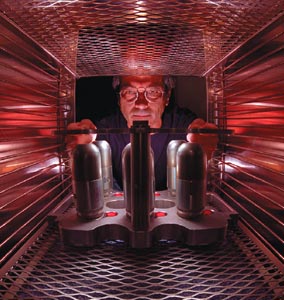Although the Bush administration is keen to develop new types of nuclear weapons, Michael Levi is optimistic that the next few years are unlikely to see any radical moves

During the 2000 American presidential election campaign, there was little doubt that George W Bush planned to take US nuclear weapons and arms-control policy in a new direction. As president, he has not disappointed. Soon after taking office, his administration explored the possibility of removing the US signature from the Comprehensive Test Ban Treaty (CTBT) – a pact it signed in 1996 that would, if it came into force, forever ban explosive nuclear testing. Although the signature was eventually left in place, the administration made no secret that the treaty would not be ratified on its watch.
Then, in early 2002, leaked excerpts from the US government’s classified Nuclear Posture Review revealed an interest in pursuing new nuclear weapons. These ranged from high-power bombs for attacking deeply buried targets – so-called bunker busters – to lower-power weapons for incinerating chemical and biological arms. Subsequent budget requests have attempted to push at least parts of this vision forward. In the background have been steady murmurings about an increasingly less reliable nuclear arsenal, implying a possible need to return to nuclear testing. Arms-control advocates and nuclear-weapons sceptics have had reason to be worried.
Yet something strange has happened in the last four years. The Bush administration has proven less enthusiastic than its critics expected, and it has been unusually unsuccessful in driving its agenda ahead. None of the key first-term issues will disappear soon, but the eventual outcomes from these ongoing battles are far from known.
New nuclear weapons
After the Nuclear Posture Review outlined a broad vision for new nuclear weapons, Congress followed quickly by appropriating funds for a Robust Nuclear Earth Penetrator (RNEP) and for an Advanced Concepts Initiative (ACI). The RNEP programme was designed to explore ways to crush deeply buried bunkers, in which enemy leaders might hide. ACI was expected to examine, among other things, “agent-defeat bombs” that would target enemy stockpiles of chemical and biological arms. Yet in the past two years, continued funding has been repeatedly curtailed or denied. Sceptics in the House of Representatives, led by Republican congressman David Hobson, have questioned the need for the new weapons and their effect on US efforts to stem proliferation around the world.
Indeed, even before the Nuclear Posture Review was leaked, details of the administration’s intentions began to become public, causing critics in the scientific community to strike back. Writing in the Federation of American Scientists’ Public Interest Report (January/February 2001), Princeton physicist Robert Nelson contended that even a small nuclear weapon – five kilotonnes in his example – would kill tens, if not hundreds, of thousands of people if detonated underground in a densely populated area.
Critical to his assessment was a claim that no weapon could dive deep enough underground to contain the radioactive fallout generated by a nuclear bomb; penetration would increase the destructive power of any particular weapon but would not stop the fallout from being dispersed. This analysis became a central talking point for sceptics of the new weapons, and in the years since, its essence has never been successfully challenged. It was further reinforced earlier this year, when a study from the National Academy of Sciences came to the same conclusion. Supporters of the RNEP have been reduced to arguing the merits of attacking targets slightly deeper underground, and of reducing – but never coming close to eliminating – fallout.
Agent-defeat weapons have not yet received such a definitive scientific treatment, but scientists have still reacted sceptically to them. The logic behind these weapons is simple. By attacking enemy stocks of chemical or biological agents, the US might disperse those agents, causing very large numbers of deaths in any surrounding population. A nuclear weapon – by virtue of its heat and radiation output – might, in theory, neutralize those agents, thus, paradoxically, saving lives. Yet both academic and government studies have concluded that the effectiveness of these weapons would depend sensitively on the precise features of any target, and on how close to any given target the weapon could strike. Given the poor state of current intelligence on enemy weapons of mass destruction – especially biological arms – decision-makers have good reason to be sceptical.
Compounding these concerns, non-nuclear alternatives to both classes of weapons appear to have considerable potential, a point I argued at length in a working paper Fire in the Hole (2002 Carnegie Endowment for International Peace). Indeed, in early 2005 Congress moved to transfer funds originally earmarked for new nuclear weapons into a broader programme that would support the development of non-nuclear alternatives. Barring a sharp, ideological turn in Congress, the future of new nuclear weapons, for the next few years, is likely to be determined by how they fare in competition against non-nuclear arms.
Stockpile stewardship
New weapons are not the only item on the nuclear agenda in the US. Since President George Bush senior declared a moratorium on nuclear testing in 1992, debate has raged in the US over whether the country can maintain a safe and reliable nuclear stockpile. The Clinton administration attempted to reassure observers by initiating the Stockpile Stewardship Management Program, which was designed to certify the continuing viability of existing weapons.
This has involved non-nuclear experiments on weapons components and assemblies, such as the implosion of inert materials with high explosives, together with computer simulations and hydrodynamics tests of nuclear components and phenomena that occur during nuclear detonations. Each year for the past decade, America’s nuclear-weapons laboratories have been able to certify that the country’s arsenal is safe and reliable, and there has thus been no apparent reason to return to nuclear testing. Despite these assurances, doubters remain.
In the past year, two new issues have complicated the debate over the legacy stockpile. The first concerns the W76 warhead, which makes up roughly 30% of the US strategic nuclear force. According to a story published on the front page of the New York Times in April, some weapons scientists say that the warheads have “a fundamental design flaw that could cause them to explode with far less force than intended”. Yet that claim appears to be weak.
The scientists interviewed for the article attacked the weapon on theoretical grounds – the most vocal contended that a critical component of the weapon “would probably fail”. But in a series of full-scale tests, conducted before the test moratorium began in 1992, the weapon performed consistently and reliably. The experimental evidence makes a mockery of the “probable” failure that the theorists have predicted – were their predictions correct, the tests would have failed too. Indeed, Everett Beckner, who directs the US nuclear-weapons programmes, has asserted that he has “high confidence that this [W76] nuclear weapon is a good design, was built properly and will function if required”. In short, the W76 debate is unlikely to return the US to nuclear testing.
A more intriguing set of questions surrounds the Reliable Replacement Warhead Program (RRWP), which was approved by Congress last autumn using funds originally approved for more controversial new nuclear weapons. The idea behind the programme is simple. The weapons in the current US arsenal were optimized for a variety of attributes – weight, size, explosive power and so on – but they were not optimized for longevity. In an era without nuclear testing, weapons that sacrifice performance in these areas, yet are extremely reliable over long periods without any need for nuclear testing, may be attractive; the RRWP is designed to explore such possibilities.
The programme confounds the standard reaction to “new” nuclear-weapons designs, since it appears to bolster the ability of the US to comply with an indefinite ban on nuclear testing – that is, with the CTBT. For that reason, many arms controllers have warmly welcomed it. Yet those observers are not without suspicions. Many think that any new warhead designed through the RRWP will still have to be tested with a real nuclear explosion – or at least they expect such testing to be demanded. At a more subtle level, some opponents worry that by exploring the need for a special “reliable” warhead, the US is conceding that its current stockpile is unreliable – and that this will inadvertently bolster arguments in favour of testing. For now, however, bipartisan backing for the RRWP appears to be strong.
The Comprehensive Test Ban Treaty
In 2001 the Bush administration began exploring the possibility of removing the American signature from the CTBT, which had already been rejected by the US senate in 1998. Since then, many observers have become suspicious that any action that might bring the US closer to nuclear testing is aimed at bringing the treaty down. Thus, for example, some claim that the RNEP is not really about destroying deeply buried targets, but about forcing a return to testing and destroying the CTBT; ditto for agent-defeat arms, the W76 controversy and the RRWP.
But this almost certainly misreads the situation. For most opponents of the CTBT, the treaty died in 1998 – they are not particularly interested in destroying the treaty through new weapons programmes because, in their minds, there is nothing left to destroy. The Bush administration does not want to be part of the treaty because it is sceptical of the value of multilateral treaties and does not want to exclude testing forever. Ultimately, then, programmes for new nuclear weapons should be considered on their own merits, not as stalking horses for plans to undermine any treaty. That said, there is nothing inappropriate about being concerned that new weapons could require new testing and thus undermine the non-proliferation regime.
Unless the Bush administration makes a push to return to nuclear testing – something that would surprise most observers – its main actions affecting the CTBT will be directed at the International Monitoring System (IMS), the network of detectors and laboratories established to monitor the Earth for evidence of clandestine nuclear tests. The administration has not, as some suspected it would, withdrawn all support from the IMS. However, it has been less engaged than it might otherwise be. In its current budget, the Bush administration has proposed paying 40% less than its full share of the costs to the group that administers the system, roughly $10m. This is a paltry sum in the US budget, and, despite denials, is certainly a discretionary reduction. Yet it accounts for is nearly a tenth of the IMS budget. It is a clear signal that, while the US values the IMS as a technical network, it opposes the broader political structure – the CTBT – within which it sits.
Those who see a strong push from within the Bush administration for a sharp departure from the nuclear status quo are not suffering from illusions – there is indeed such an aggressive strain to be found. But these most vocal nuclear enthusiasts cannot advance policy without broader support. Unfortunately for them, many elements of the US government, in Congress and in the military, are sceptical of the value of a revolution in nuclear affairs. There will be contentious debates in the coming three years, but their outcomes may not be what the Bush administration desires.



